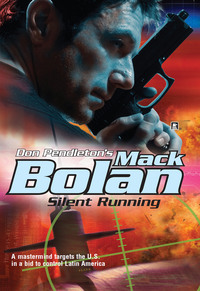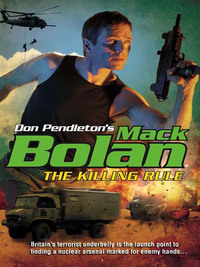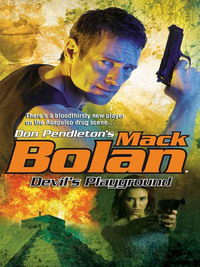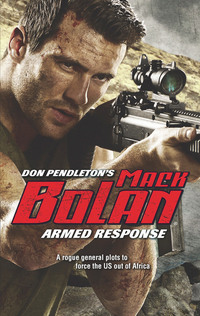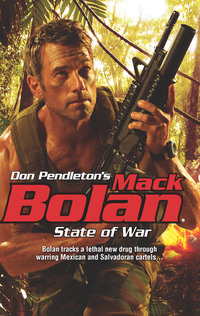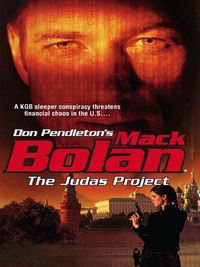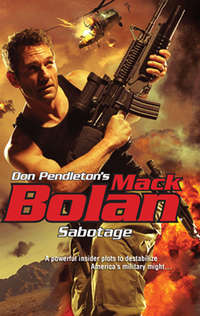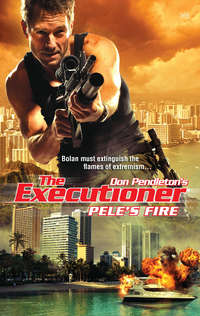
Полная версия
Savage Rule
Hell had come to Honduras.
CHAPTER TWO
Spraying full-auto bursts on the run, the Executioner aimed in the general direction of the nearest invading troops. He wasn’t concerned with hitting them; he wanted them to hear the gunfire and respond. Moving as quickly as he was, in a full sprint, he could have aimed precisely if he wished, but he could move faster by focusing on his destination: the nearest of the Saladins.
The six-wheeled light tank was an old British model equipped with a single 76-mm gun. Typically, such a vehicle also mounted coaxial and antiaircraft 7.62-mm machine guns, but Bolan saw no evidence of such weapons mounted externally on his target. There was no gun atop the turret, and the barrel of the machine gun that would otherwise poke from the turret parallel to the main gun was missing, the hole sealed and painted over.
The all-welded steel hull of the Saladin—more an armored car than a tank, really—had been painted a sloppy camouflage pattern more or less suitable to the jungle environment surrounding him. As he ran, his mind was already sorting through his extensive military knowledge, as if calling up an imaginary file. The Saladin, developed by the British in the 1950s, predated tracked light armor like the Scorpion combat reconnaissance vehicle, the Saladin’s British successor. This specimen, from what little Bolan could see of it, was likely quite old, probably manufactured in the late sixties or early seventies. It would have a gas-guzzling 8-cylinder engine mounted at the rear—though this could have been upgraded to diesel, for all he knew—and a crew of two or three. The driver would be seated forward, behind a hinged hatch, and the gunner would be to the left of the center-mounted turret. If there was a third man, a loader for the gun, he would be seated to the right of that center position.
None of this mattered. Bolan had no time to waste, not if he didn’t want to be bracketed and gunned down. He reached the tank, leaped onto the hull and pulled a pair of M-67 fragmentation grenades from his harness. Then he yanked the pin with his thumb and jammed the bombs down the barrel of the 76-mm gun.
He continued to run as gunfire erupted with much greater force around him. The muffled, staggered explosions came five seconds each after he’d pulled the grenades’ pins, doing the men inside the Saladin no good and hopefully at least distracting and confusing them. It was doubtful the blasts would cause any serious damage, given that the gun was designed to contain the force of the shells it fired, but there was at least a chance that the grenades might cause a problem. At the very least, the explosions would add to the insanity Bolan was manufacturing for the enemy to experience.
He was just getting started. He jacked open the M-203 launcher and loaded an M-576 buckshot round. Then he crouched, blending into the dancing shadows, and paused.
The enemy fire became even more intense. They were shooting in all directions, lit by the dancing fires of the burning vehicles. It was clear they thought they were being attacked from all sides, which was what Bolan wanted them to think.
The Executioner waited for the first knot of confused, frantic soldiers to close on his position, shouting to one another in Spanish. They were craning their necks at the tree line beyond their clearing, shooting sporadically into it, their fear-twisted features lit by the muzzle-flashes of their M-16 rifles. Bolan counted to three and, when they had come as close as they were likely to, he triggered the M-203.
The withering blast of buckshot from the giant bore of the 40-mm grenade launcher cut them down at waist level, leaving them broken and screaming, killing the nearest of the men who had taken the brunt of the widespread blast. Bolan was up then, squeezing precise bursts from his M-16 A-3, a veteran and virtuoso on the trigger of the familiar weapon. Soldiers, little more than thugs, fell before Bolan, who was himself the most lethal soldier they would ever encounter.
He paused, loaded another HEDP round in the M-203, and blasted yet another parked truck. The deafening sound of countless automatic weapons rolled over him in waves, much like the clouds of fitful, caustic smoke that poured from the burning vehicles. Two of the Saladins were mobile now, and one got its 76-mm gun working. It barked in Bolan’s general direction, off by many meters, the shots themselves random.
Bolan was rapidly using the ordnance with which the Farm had equipped him, but he saw no reason to hold back now. He loaded yet another HEDP grenade and, moving in a half crouch through the smoke, avoiding clumps of wildly shooting Honduran soldiers, he angled around to the rear of the closer Saladin. Lining up on the other six-wheeled tank, he punched it hard with his grenade.
The battered vehicle shuddered, but through the haze and the strobe lights of the enemy guns Bolan couldn’t tell how badly he had damaged it. Predictably, the turret traversed to bracket the Saladin next to which Bolan squatted. The soldier sprinted clear as the wounded tank fired again, this time hitting the closer vehicle.
Bolan stopped near the corpse of one of the fallen Honduran military men. He scooped up the boonie hat that many of the soldiers wore, and planted it on his own head. Then, trusting that his silhouette more closely resembled those of the invading troops, he started running urgently from group to group and shouting in Spanish, pointing at the next cluster of frenzied shooters.
Bolan hit the dirt as answering fire threatened to cut him down. The soldiers were soon eagerly, desperately shooting into their own numbers. The cry that infiltrators were among them was taken up by others. In the fusillades that ensued, Bolan was forced to roll close to one of the still-undamaged trucks to avoid the wild automatic gunfire. It wasn’t long before those in charge began shouting in Spanish for the men to cease firing. At least one of these voices was cut short, screaming, when someone else trained a gun on the man and pulled the trigger.
Creeping along over the flattened undergrowth that had been crushed by the wheels of the enemy column’s vehicles, Bolan held his rifle along his side, careful to keep it from dragging. He drew the Beretta 93-R machine pistol, flicked the weapon’s fire selector switch to single shot and began peppering the enemy again. The sound suppressor threaded onto the pistol’s barrel reduced the noise of his 9-mm rounds to a discreet cough—a sound drowned out by the automatic gunfire, terrified yelling and dying screams of the men all around him.
There was a rhythm to any combat operation, a palpable sense of motion and vibration that Bolan could feel, could pick out, thanks to so many years in the field. He rode that momentum now, felt that pulse, as he crept along in the darkness and placed his shots for maximum effect. Honduran troops fired their weapons into the trees beyond the clearing, and as they did so, several men at their left flank were felled, so it seemed, by the gunfire. When individuals there began to return fire, their shots were strangely, almost impossibly accurate, their wild blasts somehow becoming precisely aimed head shots. Bolan became the grim reaper among the disorganized, berserk gunmen, playing to their fears. By the time he was done firing covertly, the Honduran invaders seemed to be convinced, to a man, that a large group of enemy sappers had somehow penetrated their ranks.
Then the Executioner’s knives came out.
The longer blade almost leaped into his right hand, the coarse weave of the handle wrap firm in his grip as if welded there. He drew the shorter blade, its textured handle stippled for traction, and spun the knife on his palm into a reverse grip, the edge oriented toward his own body. Moving silently, Bolan used the flickering shadows, the dancing flames and flashes of gunfire to his advantage, entering his enemies’ midst, his blades flashing, stabbing and carving.
The first few soldiers went down silently, dead before they knew it. Bolan, implacable as he moved surgically forward, took no emotion from the act. There was no feeling of triumph; there was no sense of victory. He was simply performing a necessary function, grim purpose his only guide. The faces of the enemy invaders who fell before him were flash-burned onto his memory, joining the ranks of the countless others whose lives had ended as invisible notches on the grips of the Executioner’s weapons. He remembered them all; he wasn’t some unfeeling, unthinking mass murderer. The Executioner was a force for righteous redress, and as the agent of Justice, he would never shrink from acknowledging his lethal acts in that blindfolded figure’s name.
The silent knifings did more damage than Bolan’s clever shooting could have. As men began screaming, and then dying quietly, choking and gurgling in pain, a wave of renewed panic spread through the ranks of the already disorganized, terrified fighting men. Bolan narrowly avoided being shot by several Honduran soldiers who began firing at one another, screaming curses in Spanish. Rolling aside as one line of men advanced on the second, Bolan brought his large blade singing through the backs of their boots. The heavy knife chopped through the nylon and leather, slicing the left leg of the first man, both legs of the second and the right leg of a third, severing the Achilles tendons. The three folded, collapsing on limbs that could no longer bear their weight, and Bolan’s knives were the last things the shooters felt in life.
From the perspective of the opposing gunners, it was as if a line of men simply disappeared into the flickering shadows and chaos, falling away in unison. They sprayed out their magazines, firing in all directions. Bolan flattened himself to the ground as bullets buzzed above him.
Crawling out of the immediate zone of crazed fire, he paused. Before him, in a small clearing where two dozen troops were arrayed, was a giant of a man. The sleeves of his fatigues had been ripped off and the muscles of his arms bulged impossibly, the result of what could only be steroid abuse. The big Honduran, who wore an officer’s rank, was crushing the throat of one of his fellow soldiers in the thick fingers of one ham-size hand.
The men surrounding him were trying futilely to remove their comrade from the hulking officer’s grip. Each time any of them moved in, shouting, the big man shoved them back. There was a sickening crack as the officer brought up his free hand, in which he clenched a wooden-handled entrenching tool. He wielded the shovel like a battle-ax, swinging the blade through the jaw of the closest soldier.
As Bolan watched, sheltered in the lee of one of the burning trucks, the massive Honduran made short work of his own soldiers. Like a wounded animal lashing out in pain and rage—Bolan saw blood trickling down the man’s forehead, the crease in the side of his head an obvious bullet graze—he smashed them with his bloody, swollen fist, hacked at them with the shovel and stomped them under the heels of his heavy leather boots, which weren’t the lightweight jungle footwear the rest of the troops wore. Bolan raised an eyebrow, amazed at the man’s ferocity. The giant smashed the last two soldiers together and tossed them aside like broken dolls before fixing one bloodshot eye on the Executioner himself.
Something like recognition, perhaps realization, flitted across the bigger man’s face. Bolan could see the wheels move in the big soldier’s mind, even as the chaos of the miniature civil war Bolan had incited continued to swirl and rage around this temporary pocket of abrupt stillness. The officer was putting it together: Bolan wasn’t one of his men, wasn’t wearing a Honduran military uniform and wasn’t supposed to be where he clearly was, a knife in either hand. The madness that had enveloped the raiding party had suddenly become, for the big man, the result of enemy action rather than bad luck or coincidence. His expression lost its mad, frenzied, berserker cast and hardened into something else. Bolan had seen the expression before and knew it only too well.
It was murderous determination.
Whatever firearms the officer had carried weren’t with him. A flap holster on his belt was open and empty; he had lost his rifle, if he ever had one. If he hadn’t simply lost it in the melee, he had probably fired it empty and discarded it. Bolan saw the behemoth of a man grope left-handed for the weapon, which would have looked like a toy in his fist if he’d had it. He stopped, remembering that the gun was gone, and instead clenched the wooden handle of the shovel.
Bolan could have dropped his knives and gone for one of his weapons, such as the assault rifle on its sling, but that would have defeated the purpose of his creep-and-shoot, crawl-and-stick campaign. He wanted these troops so terrified of their own shadows that they continued to fire at one another, doing his work for him. No one man could take on this many soldiers alone, not directly; to succeed, Bolan had to make them fight one another. He flexed his fingers around the grips of his knives, crouched low and, nodding once, waited for the big man to attack.
The giant Honduran took the nod as the challenge he was meant to see. He bellowed and charged, raising the entrenching tool above him for a killing blow. There was no way Bolan could meet that mad dash head-on; the man was a freight train of muscle powered by berserker rage. Bolan let him come.
At the last moment, just before the Honduran came within range with his shovel, Bolan feinted with his long blade. The soldier made as if to slip past the blade, barely altering his stride. Bolan, rather than completing the slash, fell onto his back in the blood-soaked loam.
Bolan’s combat boots came up, and he shoved out with both legs. The waffle soles of his boots pressed some of the air out of the giant’s stomach on contact, but not nearly enough. Feeling the muscles in his legs straining, Bolan continued to push, carrying the giant over his body. The big Honduran landed on his head in the dirt beyond. The Executioner thought he could feel the earth vibrating, ever so slightly, as the large man crashed to the ground.
The American swiveled and surged to his feet, closing the distance between him and his opponent. The big Japanese-style blade flashed downward—
The Honduran’s hand snaked out and grabbed Bolan’s wrist.
The shock hit Bolan like an electrical charge. Pain shot up his forearm as the big Honduran crushed it in his meaty palm, as if trying to grind the bones within his grasp.
Bolan brought the shorter knife over and down for a killing blow, but the giant blocked with the shovel. Metal struck metal with a sound like a cymbal’s crash.
The noise was drawing attention.
The Honduran dropped his shovel and managed to get a grip on both of his adversary’s forearms, squeezing for all he was worth. The pain was stunning in its sudden intensity. Some men might have passed out from that alone; Bolan could see spots swimming in his vision. Even as his mind raced to find a way out of this situation, he realized that the soldiers nearest them were falling back to brace the giant—and gasping in shock as they realized that the man held in the big man’s grip was not one of their number, after all.
Bolan, with no other options, rotated his wrists. The blades of his knives came down, the reversed, smaller one doing a more thorough job than the other, but both edges slicing deeply into flesh. The giant Honduran screamed in agony and surprise as Bolan carved his way free from his grip.
Then the Executioner stepped in and drove his longer blade through the man’s neck.
The big American didn’t wait to see his enemy fall. He wrenched the big knife free, reversed it and slammed the bloody blade home in its Kydex sheath, also resheathing the smaller off-hand blade. Then his fingers curled around the grip of his M-16 A-3.
Weapons were coming up and seeking target acquisition as he blazed his way through the entire 30-round magazine on full-automatic, mowing down the first row of encroaching soldiers. He dropped the mag and inserted another, but not before triggering a buckshot round from his 40-mm grenade launcher, shredding more of the enemy.
It didn’t take him long, working amid the Hondurans and in the fitful shadows of the burning night, to bring his manufactured chaos once more to a fever pitch. Again he shouted in Spanish as he ran, misleading one man, targeting another, misdirecting a third. He poured on the firepower as the answering guns of the dwindling raiding party increased their own pitch. The jungle came alive as staccato bursts of orange-white muzzle blasts mingled with the fires consuming the vehicles, and men screamed and died by the dozens.
As abruptly as this dance of death had opened, it drew to a close. The last pockets of resistance managed to wipe out one another, either through sheer determination or with Bolan’s help. Finally, the night’s darkness began to close in once again. The muzzle-flash blooms of illumination were few and far between, and the fires licking at the scorched hulks of the vehicles, though they showed no signs of truly dying, began to subside. Once more holding his rifle by his side on its single-point sling, Bolan drew the suppressed 93-R and began to administer mercy rounds to the dying.
Then, finally, nothing moved.
Bolan made two complete circuits of the raiding party’s camp, making certain. The Executioner had walked many a battlefield and ended the lives of countless gunmen…but it would never be a casual thing to him. He didn’t dismiss them as he walked among them. He was careful to check those who might be shamming, too, using his small combat light. He would illuminate a body here, toe a corpse for reaction there, always moving lest the light make him a target.
When he was satisfied that only one other man remained alive among the raiding party, he reached down to his belt and clicked off the portable radio jammer he carried. The device, a powerful miniature electronic unit crafted by Able Team’s Hermann “Gadgets” Schwarz at Stony Man Farm, was powerful enough to prevent radio transmissions for roughly one half mile. That had been more than enough range to prevent the raiding party from calling for help or alerting the advance camp where they had been based. Bolan unclipped the jammer from his belt and examined it. It had almost depleted its lithium battery pack; the device was very strong for its size, but exacted a heavy toll from its power cell. He replaced the unit on his belt and continued tracking the raiding party’s sole survivor.
He had spotted the man during his second circuit of the devastated column. The soldier—who, like the giant Honduran Bolan had battled, wore the rank tabs of an officer—was badly wounded. He dragged himself through the muck of the clearing, among the bodies of his fallen comrades. Bolan closed in and then stopped, standing over him.
The officer turned over, painfully. The right side of his face was scorched black, and the eye on that side stared blindly. He fixed Bolan with his good eye and rattled off something in Spanish that the Executioner couldn’t catch. Then he made to grab for a rifle still clutched in the hands of a dead man nearby.
“Don’t,” Bolan said. “Leave it there.” He aimed the muzzle of the suppressed 93-R machine pistol at the wounded officer’s face. The flickering light from the truck fires was the only illumination.
“American,” the officer said, his accent heavy. “You are American.”
Bolan didn’t answer that. He stepped over and kicked the rifle out of the man’s reach. “I can provide medical treatment,” he said simply.
“Stay away,” the officer spit. He started to get up, shaking on his lacerated legs.
“Stay down,” Bolan countered.
The man didn’t listen. Perhaps given strength by sudden adrenaline, he regained his footing long enough to draw an M-7 bayonet from his belt. He lunged with the blade in a clumsy overhand strike.
Still gripping his pistol, Bolan stepped in, meeting the raised arm and slapping it down and away. He folded the man’s hand back on itself and drove the point of the bayonet toward the officer’s stomach. The wounded man lost his footing and collapsed onto the blood-soaked soil once more. The knife had never touched him. It fell to the ground next to him.
“You…you are…a butcher.” His voice had become a whisper. “Los…campesinos…sufrirán para su insolencia.”
The Executioner’s face hardened at that. “If I were a butcher,” he said, jerking his chin toward the bayonet on the ground, “that would be in your stomach right now.” He raised the 93-R for a mercy shot, but it was already too late.
“You…you…” The man’s good eye suddenly stared at nothing. The tension went out of his body as death finally took him.
Bolan shook his head. “The peasants will suffer for your insolence,” the man had said in Spanish. That was what he was fighting. According to Brognola, some unknown number of Honduran citizens had already suffered under Orieza’s ironfisted regime. Bolan didn’t intend to let that continue, or to let Orieza’s thugs bring their terror across the boarder to Honduras’s neighbors.
Bolan surveyed the ruined column one last time. Nothing and no one else moved.
The Executioner hurried off into the night, leaving only guttering flames and dead men behind him.
CHAPTER THREE
Cupping his hand over its face, Mack Bolan checked his field watch once more before replacing the ballistic nylon cover that concealed it on his wrist. The first gray rays of predawn were perhaps an hour away, maybe less. That didn’t leave him much time to operate; he would need the cover of darkness to execute his one-man assault on the Honduran base camp.
He surveyed the advance camp, taking special note of the pipeline that stood on prefabricated struts a few hundred yards to the west. Additional segments of pipe were piled nearby amid parked earthmoving and construction vehicles. The equipment and portions of the base camp itself were “protected” under camouflage netting that had proved insufficient to hide the operation from NSA’s satellite surveillance.
Bolan, crouched in the dense undergrowth bordering the cleared no-man’s-land surrounding the camp, took a moment to check the briefing on his smartphone. He had memorized the basic layout in transit, but now compared his intel to the reality of the camp before him. He saw no glaring contradictions. In the field, knowledge—real-time intelligence verified through direct experience—was invaluable. The more he knew, the more flexible he could be, tailoring his strategies and tactics to the fluid and ever-changing conditions of the modern battlefield. That was at least the theory; from long practice, the Executioner knew that a great deal was driven by sheer will, by determination and ferocity.
The camp’s layout was basic, but sound. Any trees and scrub had been slashed and burned, clear-cut around the base perimeter to deny an enemy cover or concealment. The camp itself was ringed by sandbagged machine-gun emplacements, not all of which were manned at any one time, from what he could see. The guns were FN Minimis most likely chambered in 5.56-mm NATO, Bolan suspected. Guards moved casually among the widely spaced pits, occasionally conferring with sentries stationed at other posts.
The last line of defense around the camp itself was a rough palisade apparently built from the materials cleared for the base, and topped by razor wire. Four small watchtowers, made of prefabricated metal struts, with what looked like metal-bucket crow’s nests at their tops, were placed at the corners of the square perimeter.
Even at this distance, Bolan could hear screams.
The faint sounds of human torment carried to him on the night breeze, which would have been refreshing in the Honduran undergrowth if not for those chilling noises. Bolan could just make out, through his field glasses, the blue epaulets on the uniforms of the men guarding a prefabricated metal hut near the center of the advance camp. These would be, according to the Farm’s briefing, Orieza’s shock troops. They formed the vanguard of Orieza’s campaign of terror within Honduras, according to the information in Bolan’s files.




